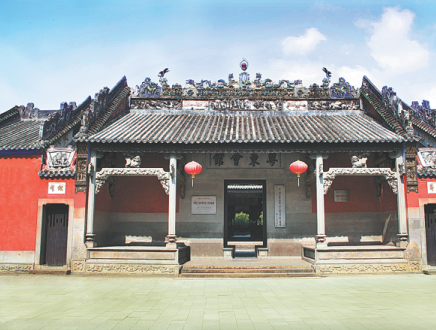Key revolutionaries highlighted among scenic attractions

The former site of the seventh Division of the Red Army base in Baise city, Guangxi Zhuang autonomous region. CHINA DAILY
As a destination of revolutionary culture, South China's Guangxi Zhuang autonomous region has singled out routes featuring pioneers to pay tribute to them.
One of the routes is themed on the late Chinese leader Deng Xiaoping. The route runs along events such as uprisings in Baise and Longzhou led by Deng and his contributions to help establish the seventh and eighth divisions of the Red Army, as well as the Zuojiang-Youjiang Revolutionary Base, extending to Nanning, Baise, Chongzuo and Hechi cities.
Focused on passing on the spirit of the old generation of revolutionaries and reliving glorious moments from revolutionary times, the route also helps visitors review the movements of the armed independent regime of workers.
According to local officials, the route crosses scenic spots including the memorial halls of the Baise Uprising and Longzhou Uprising and the Donglan revolutionary tourist attraction. Apart from the revolutionary relics, there are high-quality scenic areas such as the Dashiwei sinkhole cluster geopark and Nonggang National Nature Reserve.
At Baise city, visitors can choose from a series of scenic attractions such as the Tongtian River featuring caves and dark rivers, the former site of the Youjiang workers democratic government and the Red Army pavilion. Among these, the memorial hall of Baise records the revolutionary base of Youjiang and the history of the Baise Uprising. It features 240 artifacts, more than 1,100 pictures and a series of uprising figures.
The memorial hall of the Longzhou Uprising in Longzhou county is home to attractions including the former site of the eighth Division of the Red Army and the consulate of France in Longzhou.
This year marks the 110th anniversary of the Xinhai Revolution, launched by Sun Yat-sen, which overthrew the Qing Dynasty (1644-1911) and led to the founding of the Republic of China.
The revolutionary route that memorizes Sun's achievements and contributions is another highlight in the autonomous region.
The route focuses on Sun's activities in Guangxi and runs along the cities of Wuzhou, Hezhou, Guilin, Nanning and Qinzhou.
The route also covers attractions including Duxiu Mountain in Wangcheng, the Sun Yat-sen Park in Wuzhou and the Xiandao island park. In addition, the route sits among 5A-level attractions of the Qingxiu Mountain and the Yulong river national tourist resort.
Guangxi played a role in the democratic revolution led by Sun. The pioneer once stationed in Guilin for the Northern Expedition and launched the philosophy of promoting the military spirit.
The route enables visitors to learn about Sun's revolutionary movement and achievements in Guangxi. It also explores his dream of building a country and thus encourages people's aspirations of revitalizing and unifying the country, local officials said.
Apart from domestic pioneers and leaders, Guangxi launched a route to trace the footsteps of late Vietnamese leader Ho Chi Minh and commemorate the friendship between China and Vietnam.
The route extends to the five cities of Fangchenggang, Chongzuo, Baise, Liuzhou and Guilin. It covers attractions including the exhibition hall and the former residence of Ho Chi Minh, as well as scenic areas such as the Detian Transnational Waterfall and the world natural heritage Lijiang River.
As neighboring countries, China and Vietnam formed a deep friendship during the struggle for national independence and liberation. Between 1938-45, Ho conducted revolutionary movements in Guangxi.
Ho's revolutionary movements in Guangxi established a friendship with local people and the region became a support base for Vietnam's revolution, local officials said.
The route following Ho's footsteps in Guangxi not only reviews the revolutionary times of China and Vietnam but helps memorialize the friendship between the two countries over generations, they said.














